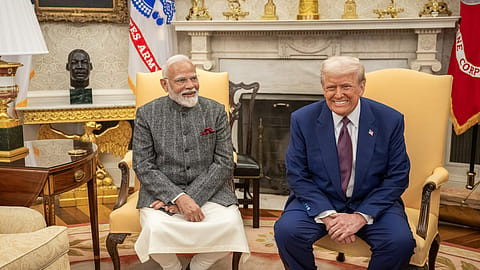Why India emerges as Trump's preferred partner in the great China confrontation
India is special to Trump and America.

Above all other countries, India is in the best position not only in the moment but also in the ongoing journey of US President Donald Trump facing down his central opponent, China.
Vice President JD Vance's India visit has set the trade and broader negotiation framework. I am confident that the agreement will be collaborative and not confrontational. There will be no retaliation. According to the finance minister, one can expect the agreement to be in place by October.
India is special to Trump and America. Beyond it being a growth and balanced-trade partner, it could be a situational political and military ally to the US whenever the two countries’ objectives converge.
I’m not saying Trump’s negotiations with India will be entirely unique. More likely, they will follow a pattern, with some special conditions.
We will know soon enough (in the next 90 days or so) what Trump's underlying approach to trade agreements will be. The first clues will come from negotiations currently underway with Japan and South Korea. Companies should take a 90-day pause before making big strategic decisions and watch for the picture to clear.
Here is the pattern I see in Trump’s approach so far:
Tariffs: Trump uses them to bring countries to the table to negotiate reciprocal trade. Fifteen countries are in line to negotiate with him. In my view, he is seeking from each nation some combination of investment in the US, such as building a plant or supplier network in America, currency appreciation, and reciprocity product by product or industry by industry. He is also seeking joint efforts to blunt China’s supply chain chokeholds.
Recommended Stories
His goal: He wants balanced trade and win-win resolutions in which both countries grow. He is flexible regarding the time it would take to accomplish it.
Currency revaluation: Exchange rate management would be an essential part of the package for almost all countries. There will not be an imposition of a general tariff if the country's currency is appreciated over an acceptable time period and the agreement is executed in good faith.
These constants will likely apply to India. But Trump has already offered something special to India and to no other country: allowing annual trade of $500 billion between the US and India by 2030. It is an enticement of growth for India.
My belief is that in exchange for balanced trade and win-win based growth, Trump wants India to buy more from the US, namely energy and defence products and services. It will be product-by-product reciprocity. India’s currency will then appreciate. It could go to 80 INR to 1 USD by December 2027.
(INR CR)
The package will likely include an agreement on work visa immigration. Trump would have some asks for India to simplify government procedures for foreign businesses to enter and function.
We need to watch the outcomes of the Trump negotiations with Japan and South Korea. Note Japan's reaction on Monday, April 21 as it protests Trump's yen appreciation requirement. Here is a fact: in 2012, the yen was 78 to 1 USD and now it is 143 to the dollar. Such an unbalanced currency exchange rate squelches competition.
Indian businesses can make plans and take some actions even as they watch for clarity and wait on strategy. There is no uncertainty that we must become globally cost-competitive, particularly against China, so we must move on that.
Compare Chinese costs after stripping out subsidies and currency disparity. Figure out how to get marginal cost to be comparable with China. Currency appreciation combined with inflation demands intensive cost improvement initiatives.
Trump's invitation for $500 billion annual trade between India and the US demands that companies devote their energy to what their fair share needs to be, how they will get it, what they need to do and what they need from the government.
Create a plan now, don’t wait for the tariff package. Why? Tariffs can be renegotiated, because they will be product by product, industry by industry. Such planning must include building capabilities, quality, delivery, and selling in foreign markets.
The government should take its time to design the right negotiating package. I believe it can get Trump to continue to postpone the imposition of tariffs until the package is discussed and an agreement is reached.
I am convinced that India’s approach will be well thought out and friendly, that US-India negotiations will be done on an amicable basis. I believe India will be well-positioned in the emerging world economic order.
Views are personal. The author is a world-renowned business adviser, author and speaker who has spent the past 35 years working with many top companies and CEOs.